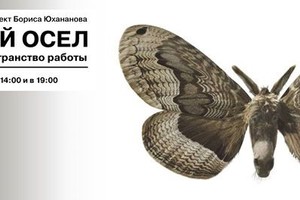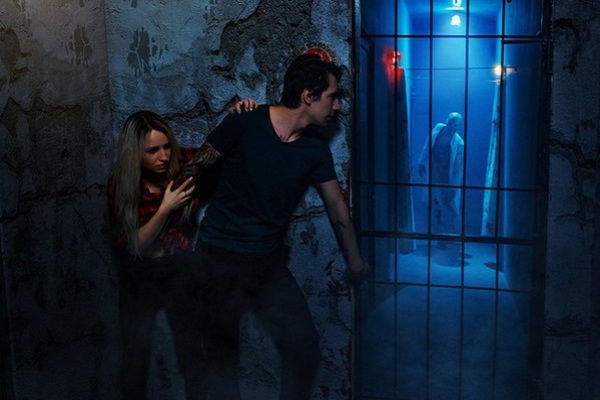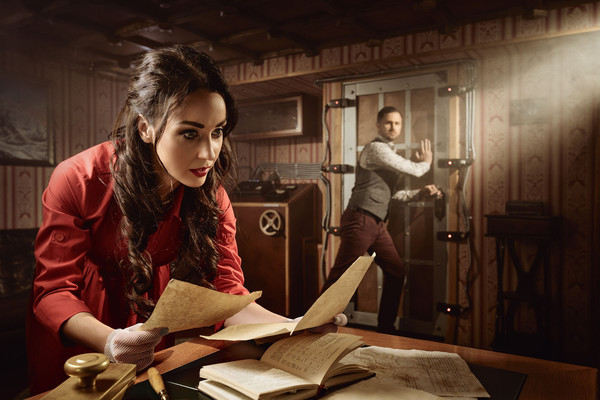Событие «„Золотой Осел. Разомкнутое пространство »
Событие «„Золотой Осел. Разомкнутое пространство »
Подробнее о событии ««Золотой Осел. Разомкнутое пространство »
Please find the English version below.
Ноябрьская публичная сессия состоится в рамках программы 18-го Международного фестиваля «Новый Европейский Театр».
Творческая группа проекта «Золотой осёл»:
Борис Юхананов — режиссер-постановщик
Иван Кочкарев — художник-постановщик
Анастасия Нефедова — художник по костюмам
Дмитрий Курляндский — музыкальный руководитель проекта
Федор Софронов — композитор-куратор
Андрей Кузнецов-Вечеслов — хореограф
Евгений Виноградов — художник по свету
Публичная сессия новопроцессуального проекта Бориса Юхананова посвящена работе над текстом Апулея «Метаморфозы, или Золотой осел».
Проект реализован в принципиально новом для отечественной театральной практики жанре Разомкнутого пространства работы. Заложенная в нем перспектива предполагает постоянное изменение, то есть развитие.
Каждый из пяти дней «Золотого осла» состоит из дневных (с 14:00 до 18:00) показов модулей — то есть самостоятельных работ участников проекта, которые могут быть представлены фрагментарно, могут в любой момент быть остановлены Юханановым и публично им прокомментированы. И вечерних композиций (с 19:00 до 23:00) — двух «Мохнатых», двух «Белых» и одного «Города».
Композиции — это готовые спектакли, построенные из сцен-эпизодов, в которых текст романа сочетается с комментарием участников действия.
Пятидневная длительность проекта отражает его структуру, устроенную как два крыла бабочки (каждое состоит из двух частей, верхней и нижней, «Мохнатой» и «Белой») и ее тела («Город»). Бабочка «рисуется» на глазах у зрителя в логической, но нелинеарной последовательности: сначала левое крыло, потом «гусеница-тельце» («Город»), и наконец — правое крыло. Как только бабочка дорисована, она взлетает, что означает превращение спектаклей-композиций в репертуарный цикл Электротеатра Станиславский. Физически бабочка тоже присутствует — она летает по сцене, живая.
Текст каждой из композиций представляет из себя сплетение фрагментов самого романа, в том числе вставных историй, так называемых «милетских басен», и живой (но зафиксированной актерами как роль) речи, в которой актер открывает нам свои переживания и размышления. Так, одним из центральных мотивов «Мохнатой» композиции становится история Психеи, влюбившейся в Купидона. При этом Психея — Алла Казакова в эпизоде из «Мохнатой» возмущенно стреляет в Купидона, который якобы украл у нее ее историю, и делает это от лица актрисы, а не героини. Внутрь композиций запущены и две инкарнации богини Изиды: Изида — Клим (Клим Козинский) и Изида — Цицер (Андрей Емельянов), которые вторгаются в спектакль с брутальными или поощрительными комментариями, спорят, следят, не покачнулись ли колонны и так далее.
«Мохнатая» и «Белая» композиции обозначены сценографически: в «Мохнатой» на сцене — мохнатые колонны, в «Белой» — белые. В «Городе», названном так из-за свойств самой композиции, — черные колонны (или — черный Парфенон).
Радикальность проекта заключается в том, что текст Апулея здесь взят целиком. А поскольку роман невозможно отделить от возникших на протяжении столетий наслоений и контекстов, то возможным способом решения оказывается художественная стратегия, в которой текст отдается на откуп разным индивидуальным сознаниям (режиссерам и артистам, сочиняющим модули).
В театральном смысле это устроено так, что история мытарств апулеевского осла перекладывается на реальную судьбу участников, которые на глазах зрителей должны пройти через «удары плетьми», чтобы заслужить статус режиссера. Параллельно нам демонстрируют разные техники ведения рассказа (эпическую и драматическую). Собственно, в совмещении их и смыкается глобальная идея сплести апулеевский «фикшн» с реальной, становящейся на наших глазах, актерской и режиссерской судьбой. Добиваясь, «чтобы личность актера, то есть вы сами присвоили себе рассказ, о котором идет речь в отрывке», и добавляя к этому свободную фантазию, Борис Юхананов размыкает пространство театра вовне, делает е го соразмерным зри телю, сидящему в зале.
Само же путешествие осла устроено так, что в первый день («Мохнатая») он не решается войти в храм, во второй день («Белая») он туда входит, а в третий («Город») начинает спуск по кругам ада, чтобы в конце концов через посвящение богине Изиде попасть в нижний мир.
Таким образом, сюжет романа Апулея становится жизнетворческой опорой для проекта в целом: Психее нужно пройти испытания, чтобы обрести благоразумие и мужество, Луций-осел посвящается в служители богине Изиде, чтобы сбросить личину животного. А участникам проекта, пробующим индивидуальный стиль в работе над одним из важнейших текстов европейской культуры, нужно получить статус режиссера. В случае Разомкнутого пространства модулей функцию Изиды берет на себя сам Юхананов, организующий участникам проекта в реальном времени и при свидетелях «побои жизни, из соображений того, что ощутить реальность можно только пройдя сквозь нее, не просто прикасаясь к ней». В отличие от репетиции, которая скрыта от глаз посторонних наблюдателей (в репетиции можно только участвовать), Разомкнутое пространство модулей — это процесс становления спектакля на глазах у зрителя, которому предлагается высказываться и даже возмущаться. Внутренним правилом «Золотого осла», таким образом, становится принцип индукции — правила устанавливаются в процессе игры. Они всегда есть, но могут быть изменены.
Расписание показов НОЯБРЬСКОЙ СЕССИИ:
Среда 23 ноября
14.00-18.00 Модули. День первый.
19.00-23.00 Композиция Мохнатая
Четверг 24 ноября
14.00-18.00 Модули. День второй.
19.00-23.00 Композиция Белая
Пятница 25 ноября. ДНЕМ — КОМПОЗИЦИЯ, ВЕЧЕРОМ — МОДУЛИ! ВНИМАНИЕ!
14.00-18.00 Композиция Город
19.00-23.00 Модули. День третий.
Суббота 26 ноября
14.00-18.00 Модули. День четвертый.
19.00-23.00 Композиция Мохнатая
Воскресенье 27 ноября
14.00-18.00 Модули. День пятый.
19.00-23.00 Композиция Белая
18+
Стоимость билетов:
Модули — 200 р
Композиции — 400 р
Стоимость абонемента на 1 день — 500 р, на 5 дней — 2000 р.
Подробности на сайте: www.electrotheatre.ru
The public session in November is an entry in the 18th International New European Theatre festival (NET 2016)
Creative team of the Golden Ass project:
Boris Yukhananov — director
Ivan Kochkaryov — set designer
Anastasia Nefedova — costume designer
Dmitri Kourliandski — project musical director
Fyodor Sofronov — composer-curator
Andrei Kuznetsov-Vecheslov — choreographer
Yevgeny Vinogradov — lighting designer
The public showings of Boris Yukhananov’s “new processual” project is devoted to work interpreting Apuleius’ novel Metamorphosis or The Golden Ass.
The project is conducted in a manner that is completely new for Russian theatre: the genre of the open-circuited workspace. The project is so constructed that it will undergo constant change and development.
Each of the five days of The Golden Ass consists of daytime showings of modules (2 to 6 p.m.) and evening compositions (7 to 11 p.m.). Modules are independent scenes created by project participants and they may be shown in fragments or interrupted by Boris Yukhananov, who publicly discusses them on the spot. Compositions consist of two “Shaggy” and “White” segments, and one “City” segment.
Compositions are fully-fledged performances consisting of episodic scenes in which the text of Apuleius’ novel intertwines with the commentary of those participating in the action.
The five-day project reflects its structure, which is constructed like the two wings of a butterfly (each consisting of two parts, the upper and lower — “Shaggy” and “White”) and its body (“City”). In this way a butterfly takes shape before the eyes of spectators in a logical, though non-linear fashion; first the left wing, then the caterpillar-body (“City”), and finally the right wing. As soon as the butterfly takes shape it figuratively takes wing — which is to say that the given composition assumes a new life as a full-fledged production in the repertoire of the Stanislavsky Electrotheatre. But the butterfly exists physically too — it flies over the stage, quite alive.
The text of each composition is an intertwining of fragments of Apuleius’ novel — including the story inserts, the so-called “Milesian fables” — and live speech (although the actors commit it to memory as if it were a role), wherein the actor reveals to us his or her own concerns and thoughts. As such, the tale of Psyche falling in love with Cupid emerges as a central motif of a “Shaggy” composition. Psyche, performed by Alla Kazakova in a “Shaggy” episode, furiously shoots at Cupid who seems to have stolen her story. She does this not as the character Psyche, but as the actress playing the role of Psyche. Two other incarnations of the goddess Isis come to life within the compositions — Klim (Klim Kozinsky) and Isis-Cicer (Andrei Yemelyanov), who interrupt performances with callous or sympathetic commentaries. They argue even as they take care the columns don’t fall over.
“Shaggy” and “White” compositions are designated by their appearance: shaggy columns grace the stage in the “Shaggy” segments, while white columns are featured in the “White” segments. The “City” compositions are so named for their content and they feature black columns (i.e., a black Parthenon).
One radical aspect of the project is that it embraces Apuleius’ text in its entirety. Insofar as the novel is impossible to separate from all the layers of meaning and contexts that have accrued to it over the centuries, one way of approaching it is to employ an artistic strategy by which the creative individuals (directors and actors creating the modules) are given free reign with the text.
This is organized theatrically so that the tribulations faced by Apuleius’ ass in a literary setting are transferred to the performers themselves. In plain view of the audience they suffer every requisite “whip lash” in order to earn the status of director. We simultaneously see demonstrations of various interpretations of the tale (in epic and dramatic form). This combination of the two gives rise to the grand idea of intertwining Apuleius’ fiction with actors’ and directors’ real-life experiences right before our eyes. Yukhananov wants “every individual actor, that is you yourself, to assimilate personally the tale or excerpt you are working on.” To that he adds unhindered imagination, thus opening up the space of theatre to the outer world, making it accessible to the spectator in the hall.
As for the journey of the ass, it is organized so that on Day One (“Shaggy”) he fears to enter the cathedral; does resolve to enter on Day Two (“White”); and, on Day Three, begins the descent through all the circles of hell so that ultimately, through initiation, he approaches Isis in the netherworld.
Thus does the tale of Apuleius’ novel become the creative life-support for an entire project. Psyche must be tested in order to attain prudence and courage. Lucius the ass is initiated as a servant to the goddess Isis in order to cast off the mask of the animal. Any project participant who wishes to try out his or her own individual style while working on one of the most important texts of European culture must first achieve the status of director. In the case of the Open-circuited workspace of modules Yukhananov himself takes on the function of Isis and in real time, before witnesses, delivers unto participants “the blows of life with the knowledge that the only way to experience reality is to go straight through it, not merely touch it.” Unlike rehearsals, which are kept hidden from stray witnesses (one can only participate in rehearsals), the Open-circuited workspace of modules is a process by which a performance takes shape before the eyes of spectators who are given the opportunity to have their say and even rebel. As such, the principal of induction emerges as the fundamental law of The Golden Ass — laws are made in the process of performance. They always exist, but they can be changed.
Schedule of November showings:
Wednesday, November 23
2 — 6 p.m. Modules. Day One.
7 — 11 p.m. Composition Shaggy.
Thursday, November 24
2 — 6 p.m. Modules. Day Two.
7 — 11 p.m. Composition White.
Friday, November 25 ATTENTION! COMPOSITIONS RUN IN DAY; MODULES IN EVENING!
2 — 6 p.m. Composition City.
7 — 11 p.m. Modules. Day Three.
Saturday, November 26
2 — 6 p.m. Modules. Day Four.
7 — 11 p.m. Composition Shaggy.
Sunday, November 27
2 — 6 p.m. Modules. Day Five.
7 — 11 p.m. Composition White.
18+
Tickets:
Modules — 200 rubles
Compositions — 400 rubles
A full-day pass costs 500 rubles; a five-day pass costs 2,000 rubles
Архив расписания
Отзывы

К сожалению, на это событие ещё никто не оставлял отзывов.
Будьте первым!


.jpg)


.jpg)

Оставить отзыв